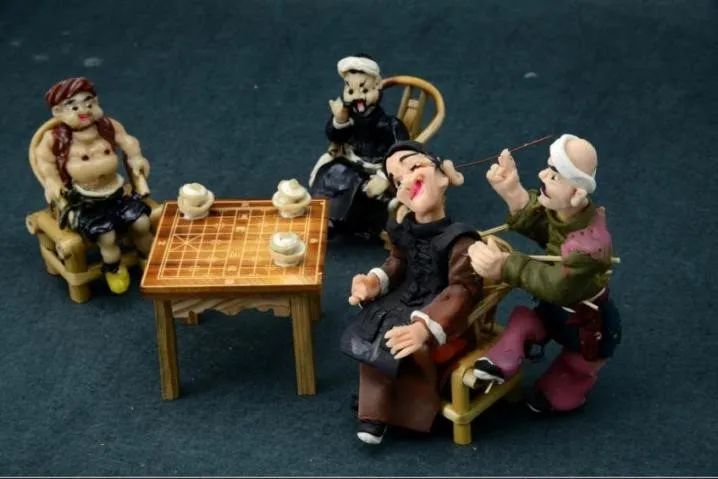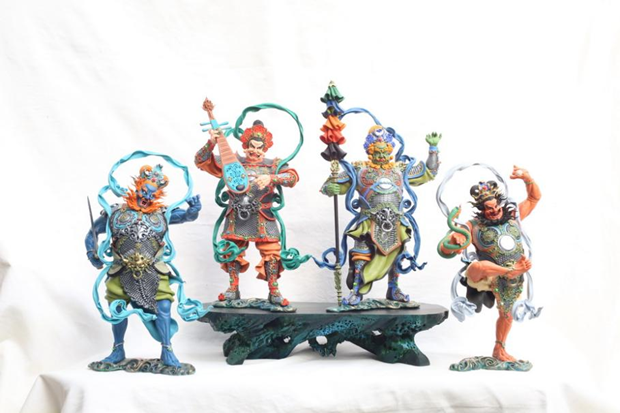记忆的味道
官话方言
官话方言是我国七大方言区中分布范围最为广泛的一大方言,又可以细分为华北方言、西北方言、西南方言和江淮方言。因此,在官话方言区中,面塑艺术依托于各地方言口口相传,描绘出中华大地缤纷多彩的面塑技艺画卷。(Mandarin, the official language of the seven Chinese dialect groups, is the most widely spoken tongue, which can be further divided into the northern dialect, the northwestern dialect, the southwestern dialect, and the Jianghuai dialect. It is through these diverse sub-divisions of Mandarin that the art of dough figurine making is passed down and spread, and in the meantime, growing increasingly dynamic.)

“捏面人、画糖圈,吃了没玩的,玩了没吃的”,(Dough figurines and sugar paintings are both not only delicious, but also just plain fun.)捏面人如做泥人、吹糖人一样,是一项祖传民间手艺,算得上“九佬,十八匠”中的一匠,见得着的都称“捏面人的”,最欢喜的是馋嘴的孩子。
本期“记忆的味道”将带领大家一同探寻官话文化,走进武汉面塑的世界。
面塑艺术的造型完整饱满,形态略有夸张,手法简练、注重神气,淳朴敦厚、色彩艳丽,普遍流行在我国黄河内外、大江上下的很多地方。如京津冀、陕西、山西、山东、四川、河南、江苏、上海等地。(The art of dough figurine making can be seen in many places in China, including Beijing, Tianjin, Hebei, Shaanxi, Shanxi, Shandong, Sichuan, Henan, Jiangsu and Shanghai.)因各地风俗习惯不同,也使得面塑的品种多样,内容丰富。如黄河流域表现为古朴、豪放、深厚;长江流域则是细致、优美、精巧。(The dough figurines come in diverse forms and meanings as customs vary in different areas. They can be found in either simple, bold or culturally sophisticated forms in regions along the Yellow River, or in elaborative, elegant, or delicate forms in areas along the Yangtze River.)
01面塑是什么
面塑,俗称面花、礼馍、花糕、捏面人。是指以面粉、糯米粉、甘油或澄面等为原料制成熟面团后,用手和各种专用塑形工具,捏塑成各种花、鸟、鱼、虫、景物、器物、人物等具体形象的手工技艺。(The dough figurine making refers to the craftsmanship of using flour, glutinous rice flour, glycerol, or wheat flour as raw materials to make steamed doughs and knead them into different concrete images such as flowers, birds, fish, insects, sceneries, artefacts, and characters by hand or with the help of modeling tools.)

02 面塑的历史发展
面塑最早起源于吃食,作为蕴含祝福意义的食品或者祭祀的供品。(Initially, dough figurines are made as food with blessings or used as offerings for sacrifices.)
面塑艺术早在汉代就已有文字记载,人们把面粉蒸制成一定的形象,为食用增强装饰效果。(Records of dough sculpturing can be found as early as the Han Dynasty when steamed doughs were made into certain shapes for decoration.)
到了宋代,捏面人已经成为民间节令很流行的习俗。南宋孟元老《东京梦华录》中记载:“寒食前一日谓之炊熟,用面造枣锢,飞燕,柳条串之,插于门楣,谓之子推燕”。当时面点,有“甲胄”人物、“戏曲”人物、“孩儿鸟兽”、“飞燕形状”等,可谓“奇巧百端”。
明清时期,面塑逐渐脱离食用,开始具有很强的艺术价值和经济价值。(During the Ming and Qing Dynasties, dough figurine making became a handicraft of great artistic and economic value, no longer just a means to make food.)一些四处奔波的面塑艺人出现在繁华闹市,以此为生计,进一步促进了其艺术水平的提高。
近代,受文人艺术的影响,面塑的内容和形式不断出新,王公贵族不惜重金订购,或作贺礼馈赠亲朋,或作陈设摆放在自家案头。
如今面塑因其时代文化的积淀和创作者不断进取的热情和才思而倍受世人青睐。

03 面塑在时节中的寓意
面塑在我国传统时节中也有着特殊的寓意:新春佳节,面塑的主要用途是对天、地、神进行祭祀祈祷,这是民间百姓追求丰衣足食的生活理想的体现,也是一种对美好生活的祝福。(During the Spring Festival, dough figurines are made to offer sacrifices and prayers to the heaven, earth and god, which is the embodiment of the ordinary people’s ideal of living in abundance and a blessing for a better life.)
而当清明节来临时,北方几乎家家户户都有蒸寒燕、捏面人,迎接万物复苏的习俗。“捏寒燕”是我国黄河流域民间的一种节日习俗,人们用柳枝或棉线将一串串寒燕连接起来挂在房檐下,吸引鸟来自家屋檐下居住,是体现自家兴旺和日子红火的方式,也有着迎接、祈福春天来临的寓意。(People made dough swallows to show their prosperity and express their best wishes to the coming spring.)
湖北武汉地处中国中部,南来北往的面塑艺人们在这里交融互鉴,形成的捏制风格细致精美、灵动浑厚,展现了源远流长的荆楚文化特色。(Wuhan, Hubei Province, is located in central China. Here, the development of dough figurine making has benefited from the exchanges of the north and the south, which has led to the creation of a style that is both sophisticated and vigorous, a showcase of the unique Jingchu culture.)在“百年百艺·薪火相传”中国传统工艺邀请展上,武汉面塑传承人刘洁的参展作品《四大天王——风调雨顺》不仅有着美好的寓意,也寄托着祝愿祖国“风调雨顺”、“国富民强”的个人情感。

面塑作品《四大天王——风调雨顺》
04 面塑的传承与发展
面塑作为中华传统文化,也是我国重要的非物质文化遗产,需要我们传承与创新。(As part of the Chinese traditional culture, dough figurine making is a major national intangible cultural heritage, which deserves preservation and innovation.)近年来,越来越多的面塑作品让人眼前一亮,手工艺人用富有创意的方式,让面塑文化得到传承并发扬光大。
在面塑传统与现代题材的碰撞下,面塑匠人谷向柯先生表示,“面塑的发展肯定会越来越好,素材越丰富越好,这样发展的方向也就越多。市场也会与时俱进,慢慢扩大,受众也会越来越多。”与此同时,谷向柯先生还提到,在现代工艺的加持下,面塑的色彩更加丰富,不易变色与腐烂,能够保存上百年。(Thanks to modern technology, the dough figurines nowadays have become more colorful and resistant to discoloration and decay, which will allow them to last for centuries.)

面塑匠人谷向柯先生
一面一世界,一粟一人生。(A world in a dough, a lifetime in a grain.)手工艺人注之以情感,赋之以灵魂。透过面塑与历史相望,我们一脉相承的文化记忆,在这个时代以丰富的形式,焕发新的生机。
参考文献:
1. 光明网《【非遗传承】面塑非遗传承人刘明凤:面团在指尖生花》
https://m.gmw.cn/baijia/2020-05/13/33826366.html
2. 文旅中国《百城百艺 非遗展播 | 刘洁:武汉面塑的每一尊作品都不可复制》
https://www.ccmapp.cn/news/detail?id=48b58640-8b29-4e70-9589-a1df0a2169db
3. 澎湃新闻《湖北话像四川话?或许反过来才对》
http://www.thepaper.cn/newsDetail_forward_15092396
4. 长江商报《“油面糖蜜造如笑靥儿”》
www.changjiangtimes.com/2012/02/376093.html
5. 孙超. 浅谈面塑的发展[J], 家庭生活指南, 2019年05期.
部分资料、图片来源于网络
资料搜集|马欣萌 陈嘉希
编辑|王南 尼玛顿珠
翻译|孙雪
翻译指导|杨祎辰
排版|王玉
审校|卓诗莹 高铭洁 鲜琦
审核|曹原
策划 | 上外英院传统文化志愿服务队

我要评论 (网友评论仅供其表达个人看法,并不表明本站同意其观点或证实其描述)
全部评论 ( 条)